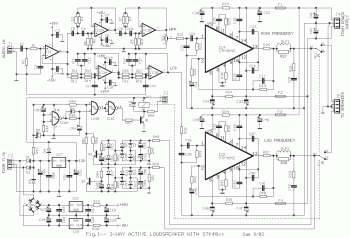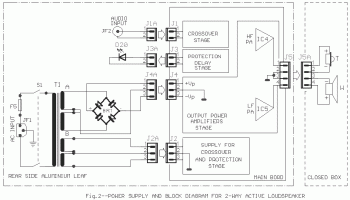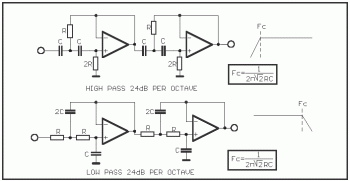Active speakers have many advantages over the simple speakers using passive materials for implementing the components separation of frequencies. In the case of active speakers have proportionally higher manufacturing costs, since each loudspeaker is driven by its own amplifier. In a properly designed active speaker, the sound quality is much better and very low distortion, because it uses inductors and capacitors in the signal path,. Those capacitors are on the path of the signal have a very small price and very good quality. This does not mean that a well designed passive speaker is good, maybe better than an active. Unlike an active speaker is much more difficult to manufacture.
In [Fig.1], is an active channel speaker 2-way. As shown in the Block diagram [Fig.2], is a classical crossover 2-way crossover fc = 3100HZ -24dB/oct. This frequency was chosen because it is near the crossover of many speakers of trade, but can be changed and customized to your choice of speakers, enough to use the formulas give for the calculation [Fig.3]. The IC1 makes the adjustment input filters around the IC2 create a high pass filter frequency for frequencies above Fc = 3100HZ, contrast material around the IC3 create a katodiavato filter for frequencies below 3100HZ. With the trimmer TR1 in the line of high frequency can be adjustable, if necessary, the level between the two loudspeakers. You will usually need to be lowered by 10% the level of the tweeter than the woofer. In many parts of the filter capacitors and resistors are not used, but it's there for future changes, another crossover as the R6-10 not used.
In the next stage the two outputs of the filter led to two power amplifier in IC4 for high frequencies and IC5 for low. These are two of Sanyo hybrid integrated output 80W/8ohms with very good features and sound. Can be changed to another type of series as STK4036, STK4038, STK4040, with a corresponding modification of power supply. This series is used in many cases active speaker with very good audio results. Good is to use the formula STK4042XI, because it has more modern interior design in relation to the type STK4042II. The filters RLF1-2 at the output of amplifier consisting of the resistor R27 and R38 and a coil wrapped around it in three layers. The coil is made with 25 to 30 turns of copper wire with a diameter of 1mm. In the output amplifiers are the contacts of relay RL1, which is controlled by the DC protection and delay. This circuit is located around the IC6 and works as follows: When the circuit is powered by a tendency there is a delay of 5 sec to connect the speaker outputs on the amps so they do not hear the noises of charging capacitors. Unlike when you stop feeding the circuit then RL1 disconnect quickly the speakers from the amplifiers, so they do not hear the noise discharge of capacitors. While the circuit protects speakers from continuing trends that will occur for any reason, the output of power amplifier , opening the contacts of RL1 and disconnecting very fast loudspeakers.
The circuit protection is evident from Led [D20], which should be placed prominently on the speaker box. The wiring is shown in Fig.2. The AC cord is toroidis good quality. The mainboard, the heatsink, the power transformer, bridge rectifier BR1, as well as all materials that appear outside board mounted on an aluminum block suitable size which adapts to the dimensions of the box and put the speaker on the back of the box. The two amplifiers IC4 and IC5 are screwed onto the back of the heatsink. The overall efficiency of the speaker always depends on the characteristics of units Tweeter and Woofer which used to it, as well as the design and quality of the box. Earliest used in place of the tweeter and woofer T33A B200G of the KEF.
Part List
|
| R1-21-32-25-36-58=1 Kohms | C19-20-52=10uF 25V | IC1=TL071 |
| R2=47 Kohms | C21-35=470pF | IC2-3=TL072-NE5532 |
| R3-4-5-7-8-9-46=22 Kohms | C22-36=470nF 63V MKT | IC4-5=SKT4042[XI] or [II]*See text |
| R6-10=N.C *See text | C24-25-26-38-39-40=100pF | IC6=4093 |
| R11........18=22 Kohms | C27-41=10pF | IC7=7812T |
| R19-20=47 ohms | C28-42=100nF 100V MKT | IC8=7815T |
| R22-33=33 Kohms | C29-43=1nF 63V MKT | IC9=7915T |
| R23-24-34-35=100 ohms | C30-34-44-48=100uF 63V | RL1=Relay 12V [G2R2 Omron] |
| R26-37=0.22 ohms 5W | C31-45=220uF 25V | RLF1-2=*See text |
| R27-38=10 ohms 3W | C32-33-46-47=10uF 63V | F1-2-3-4=1.6A FAST 5X20mm |
| R28-39=6.8 ohms | C49=47uF 25V | F5=1A SLOW 5X20mm[Fig.2] |
| R29-40=12 Kohms | C50-51=100nF 63V MKT | T1=220V//A=2X30V 250VA B=2X15V 30VA [Toroidal] |
| R30-41-53-54=10 Kohms | C53=1uF 25V | |
| R31-45=560 ohms | C54=3.3uF 25V | |
| R44-45=1 Mohms | C55-56-58-59=33uF 63V | JF1=3pin male supply jack |
| R47=39 Kohms | C57-60=22uF 16V | JF2=Female RCA Jack |
| R48-50=15 Kohms | C61-62=15000uF 63V AXIAL | J1-3=2pin conn. with 2.54mm pin step |
| R49-51-52-55=56 Kohms | C63-64=2200uF 25V AXIAL | J2=3pin conn. with 2.54mm pin step |
| R56-57=3.9 Kohms | C65-66-67-68=100nF 63V MKT | J4=3pin conn. with 3.96mm pin step |
| R43=470 ohms 1W | Q1=BD679 | J5=4pin conn. with 3.96mm pin step |
| TR1=47 Kohms trimmer horizontal | Q2-3=BC550 | T=Tweeter 8ohms 50 until 80W |
| C1-22-36-23-37=1uF 63V MKT | D1-2-3-4=1N4002 | W=Woofer 8ohms 50 until 100W |
| C2=390pF | D5=8.2V 0.5W Zener | BR1=Bridge rect. 400V 25A [Fig.2]* See text |
| C3-4-7-8-14-15=100nF 63V MKT | D6=1N4148 | BR2=Bridge rect. 100V 1.5A |
| C5-6-9-10-11-12=3.3nF 63V MKT* See text | D7.....19=1N4148 | All resistors is 0.5W 1% metal film except for announce differently |
| C13-16-17-18=3.3nF 63V MKT*See text | D20=5mm LED [Fig.2] |
2 Way Active Speaker with STK4042 source: http://users.otenet.gr/~athsam/2_way_active_loudspeaker_eng.htm
About Audio Amplifier
An audio amplifier is an electronic amplifier that amplifies low-power audio signals (signals composed primarily of frequencies between 20 - 20 000 Hz, the human range of hearing) to a level suitable for driving loudspeakers and is the final stage in a typical audio playback chain.
The preceding stages in such a chain are low power audio amplifiers which perform tasks like pre-amplification, equalization, tone control, mixing/effects, or audio sources like record players, CD players, and cassette players. Most audio amplifiers require these low-level inputs to adhere to line levels.
While the input signal to an audio amplifier may measure only a few hundred microwatts, its output may be tens, hundreds, or thousands of watts. More explanation about power audio amplifier can be found at wikipedia.org
An audio amplifier is an electronic amplifier that amplifies low-power audio signals (signals composed primarily of frequencies between 20 - 20 000 Hz, the human range of hearing) to a level suitable for driving loudspeakers and is the final stage in a typical audio playback chain.
The preceding stages in such a chain are low power audio amplifiers which perform tasks like pre-amplification, equalization, tone control, mixing/effects, or audio sources like record players, CD players, and cassette players. Most audio amplifiers require these low-level inputs to adhere to line levels.
While the input signal to an audio amplifier may measure only a few hundred microwatts, its output may be tens, hundreds, or thousands of watts. More explanation about power audio amplifier can be found at wikipedia.org
This is a video tutorial about how to a very simple audio amplifier based on the LM386 amplifier chip. It can be built for less than $20 (or might be less than $8 in some countries) and used to amplify any low level audio signal including a guitar, bass or mp3 player.
Watch the video:



No comments:
Post a Comment